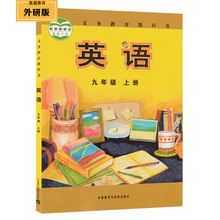导读: 编写教案要依据教学大纲和教科书。从学生实际情况出发,精心设计。一般要符合以下要求:明确地制订教学目的,具体规定传授基础知识、培 ...
外研版九年级英语教案
九年级英语上册全册教案(外研版)
Module1 Wonders of the world教案
课题 Unit1 What is a wonder of the world 课型 New
教学目标 Key vocabulary: ancient, club, composition, pupil, meeting, call, even
Key structures: That’s news to me! What’s it about? Listen up, everyone.
Anyone else? That’s a fantastic idea listen up
教学重点 Get to know the wonders of the world
教学难点 Language points
教具 多媒体,tape 课时 2
教学课程 Step1 Warming-up and listening
1. Look at some pictures of the wonders of the world.
2. Talk about the picture. You can use the words in the box to help you.
3. Listen and check the words you hear.
Step 2 Listening and reading
1. (Close the books) Listen to the tape carefully.
2. Ask the students to read through the conversation individually.
3. Play the tape and have them read and follow.
4. Act it out.
5. Learn Everyday English
Step 3 Do Exercises
1. Choose the best answer in Activity 4.
2. Listen again and check.
3. Answer the questions in Activity 5.

Step 4 Explain the important and difficult points
Step 5 Pronunciation and speaking
1. Listen to the sentences.
2. Listen and repeat.
3. Say the sentences aloud.
Step 6 Homework
Finish the exercises in the workbook Ex. 1, 2, 3&4
个人修改
Revise what we learnt last term.
Show the pictures and learn the new words.
Read the key sentences.
Read the dialogue in roles.
2015外研版九年级英语下册全册教案外研版
Module1Travel
一、学习目标:
A.单词和短语:
flight,becauseof,direct,pilot,succeed,aslongas,school-leaver,exactly,takecare,sir,officer,stupid,takeoff,jacket
B.交际用语:
1.Notbad!
2.Itwasgreatfun!
3.Howaboutyou?
4.We’dbettergetbacktowork.
5.We’llhaveagreattime!
6.—Whatdidyoudoduringthewinterholiday?
—IwenttoseemygrandparentsinXi’an.
7.ThetrainwasfullofpeopleandIhadtostandforthreehours!
8.Butthepilotsucceededinlandingontime.
9.There’snothingtoworryaboutaslongasyouworkhard.
10.Pleasehaveyourticketsready.
11.Oh,it’salongstory
12.HewenttostaywithhisfamilyintheUK.
13.Whyistravelsodifficultinwinter?
14.WeflewdirecttoHongKong.
15.WetookatourbycoachtotheSummerPalace.
16.ThenwetookaboattoLantauIslandandwenttoDisneyland.
17.ThisisSeat12A,butyoushouldbeinCar9.ThisisCar8.
二、教学目标
1.Function:Talkingabouttravel.
2.Structure:Revision:nouns;articles;numbers.
3.Skills:1)Listeningforspecificinformation;takingnotes..
2)Talkingaboutfamiliartopics(holidays)
3)Predicting;readingforspecificinformation.
4)Writingashortplayaboutatrip.
4.Aroundtheworld:ThefirstpilottoflyaloneacrosstheAtlanticOcean.
5.Task:Writingandactingoutashortplay.
三、重点及难点:
Grammar:Revision:nouns;articles;numbers.
四、教学设计:
Unit1Wetouredthecitybybusandbytaxi.
ⅠTeachingmodel
Listeningandspeaking
ⅡTeachingmethod
Communicativeapproach
ⅢTeachingaims
1.Tounderstandtheconversationsconversationwithregardto“travel”.
2.Totalkaboutone’sholidayandnewterm..
ⅣTeachingObjectives
1.Keyvocabulary:flight,becauseof,direct,pilot,succeed,aslongas,school-leaver,exactly
2.Keystructures:Sentencestructure
ⅤTeachingaids
Taperecorder,OHP,video
ⅥTeachingSteps
Step1Warmingup
1.Showsomepicturestotalk.
1)—Howdoyougotoschool/work?
—Igotoschoolby______.
2)—Howdoyoumostliketotravelby?
—Imostliketotravelby_________.
2.Enjoyandtalksomethingaboutthepictures.
3.Showsomepicturestointroducethenewwords.
4.Learnthenewwords.
5.Readthewordsaftertheteacher.
Step2Completethesentences.
1.AskthestudentstoreadthroughthesentencesinActivity1.
1)Imostliketotravelby_____________.
2)Ileastliketotravelby_____________.
3)Itravelmostoftenby______________.
4)Itravelleastoftenby______________.
2.Completethesentencessotheyaretrueforyou.
3.Askthestudentstochecktheiranswerwithapartner.
4.Callbacktheanswersfromthewholeclassandchecktheanswers.
Step3Listeningpractice.
1.AskthestudentstoreadthroughthesentencesinActivity2.
1)Theflighttakesabout__________hours.
2)Timedifference:__________hours.
3)Flightnumber:__________
4)From_________to_________
5)Leaveat(newtime):_________
6)Arriveat(newtime):_________
Keys:10,8,CA938,London,Beijing,11:30,5:30p.m.
2.Playthetapeandaskthestudentstolistentothetapecarefully.
3.Listenandcompletethenotes.
4.Askthestudentstochecktheiranswerwithapartner.
5.Callbacktheanswersfromthewholeclassandchecktheanswers.
Step4Listenandread.
1.Askthestudentstolistenandreadtheconversationsilently.
Whenyoulistentotherecording,trytonotedownthekeyinformation.Yournoteswillthenhelpyouretellthemaininformation.
2.Nowcompletethetable.
Holidayactivities
Lingling
wenttoseehergrandparentsinHenanProvincebytrain
Tony
Daming
Betty
4.Askthestudentstochecktheiranswerwithapartner.
5.Callbacktheanswersfromthewholeclassandchecktheanswers.
Keys:
wenttostaywithhisfamilyintheUKbyplane.
flewtoHongKongandvisitedLantauIslandDisneyland.
touredBeijingbybusandbytaxiandtookatourbycoachtotheSummerPalace.
Step5Answerthequestions.
1.AskthestudentstoreadthroughthequestionsinActivity4.
1)Whendoyouthinktheconversationtakesplace?
2)AccordingtoLingling,whyistravelsodifficultinwinter?
3)WhatareDamingandBettylookingforwardtoattheendoftheterm?
2.Answerthequestions.
3.Askthestudentstochecktheiranswerwithapartner.
4.Callbacktheanswersfromthewholeclassandchecktheanswers.
Keys:
1.Theconversationtakesplaceinwinter.
2.TravelisdifficultbecauseoftheSpringFestival.
3.Theyarelookingforwardtotheschool-leavers’party.
Step6Choosethecorrectanswer.
1.AskthestudentstoreadthroughthewordsintheboxinActivity5.
directexactlypilotsucceed
2.Choosethecorrectanswer.
1.Whenyouflydirect,you______.
a)arrivewithoutstoppingatanotherplace
b)stopatanotherplacebeforeyouarrive
2.Whenyousay“Exactly”,itmeans______.
a)youdonotagree
b)youcompletelyagree
3.Thepilotofplane______.
a)fliesit
b)givesyoufoodanddrinkduringtheflight
4.Ifyousucceedindoingsomething,you______.
a)managetodoit
b)nearlydoit
3.Askthestudentstochecktheiranswerwithapartner.
4.Callbacktheanswersfromthewholeclassandchecktheanswers.
Keys:1.a2.b3.a4.a
Step7EverydayEnglish
Notbad!
Itwasgreatfun!
Howaboutyou?
We’dbettergetbacktowork.
We’llhaveagreattime!
Step8Pronunciationandspeaking:Listenandmarkthepauses.
1.Playtherecordingoncewithoutstopping.
2.Playtherecordingagainandaskthewholeclasstorepeat.
Lingling:Howaboutyou,Betty?
Betty:WehadquitagoodtimeinBeijing.Wetouredthecitybybusandbytaxi.Lastweekend,wetookatourbycoachtotheSummerPlaceandwentforalongwalkaroundthelake.
Lingling:Thatsoundsgreat!Butnow,we’dbettergetbacktowork.We’regoingtohaveabigexamattheendoftheterm.
3.Askthestudentstolistenandmarkthepauses.
4.Nowlistenagainandrepeat.
Step9Workingroups.
Talkaboutyourwinterholiday.
1.Askandansweraboutwhatyoudidduringthewinterholiday.
—Whatdidyoudoduringthewinterholiday?
—IwenttoseemygrandparentsinXi’an.
2.Talkaboutwhathappenedduringthetrip.
ThetrainwasfullofpeopleandIhadtostandforthreehours!
Step10Languagepoints
1.Butthepilotsucceededinlandingontime.不过飞行员成功地按时着陆了。
succeedindoing…表示“成功地做……”。例如:
1)Hesucceedinworkingoutthemathsproblem.他成功地解出了这道数学题。
2)WefinallysucceedingettinglittleJohnnyupthestairs.
我们最后成功地让小约翰尼上了楼梯。
2.There’snothingtoworryaboutaslongasyouworkhard.只要你努力,没什么好担心的。
aslongas在这里引导条件状语从句,表示“只要”,也可以用solongas表示同样的意思。例如:
1)Youcaninviteyourfriendsas/solongasyoutellmetwodaysbeforetheparty.你可以邀请朋友来,只要在聚会前两天告诉我就行。
2)Myparentsdon’tcarewhatjobIdoas/solongasI’mhappy.我父母对我从事什么工作无所谓,只要我开心就好了。
Step11Revision:nouns
名词专项复习:
名词有可数与不可数之分,有数和所有格的变化,在句中可以作主语、宾语、宾语补足语、表语、同位语等。
1.可数名词与不可数名词
很多情况下,我们可以依靠常识(即用数数的办法)来判断英语名词是否可数。比如,book,table都是可数名词而water是不可数名词。一般来说,在英语中物质名词和抽象名词都是不可数名词,如flour,rice,beauty,pleasure,money等。
学习名词必须区分其是否可数。只有可数名词前才可以使用数词和不定冠词。值得注意的是,有时同一个单词所指不同,其数的概念也就不同。例如,paper作“纸”解时为不可数名词,表示“报纸”和“试卷”时是可数名词;fish指“鱼肉”时是不可数名词,表示“鱼”时是可数名词,只不过通常是单复数同形;coffee做“咖啡”解时是不可数名词,表示“一杯咖啡”时是可数名词。
2.名词的数
对于可数名词数的变化,一要掌握规则变化,即名词后面加-s或者-es的情况;二要掌握不规则变化,包括man-men,woman-women,foot-feet,tooth-teeth,mouse-mice,child-children等;三要掌握单复数同形的单词,如sheep等。除此之外,还应注意以下几点:
1)在一般情况下,复合名词的单复数形式体现在最后一个名词上,如apencilbox-pencilboxes,agirlstudent-girlstudents。但是如果是由man或woman构成的复合名词,如amandoctor,awomanteacher,其复数形式则为mendoctors,womenteachers。
2)有些名词往往以复数形式出现,如trousers,glasses(眼镜),在表示数量时需要借助量词,如apairoftrousers,threepairsoftrousers。
3)有些名词表示复数概念,往往作为一个整体看待,如police,people。这些单词没有复数形式。但是其后面的谓语动词却多为复数形式。例如:Thepolicehavecaughtthethief.Manypeoplehaveseenthefilm.如果要表达单个数量只能换用其他单词。例如:“一名警察”是apoliceman/policeman,“一个人”可以是aperson,aman,awoman等。不过要注意,people作“民族,种族”解时,是可数名词,复数形式是peoples。
3.名词的所有格
名词的所有格一般采用名词后加’s的形式,如achild’sdream,someone’sbag;以-s结尾的复数名词的所有格直接加’即可,如theboys’schoolbags。所有格表示的是所属关系,采用’s结构的多为有生命的名词。如果是无生命的名词,多采用“of+名词”的方式表达。例如:
thewindowofthehouse房子的窗户
theendoftheyear年底
thegateofourschool我们学校的大门
注意,afriendofmyfather’s与myfather’sfriend的含义不同,前者含有“我父亲有不止一个朋友”的意思,而后者没有这一含义。
4.名词的句法功能
名词的句法功能指名词可以充当的句子成分,常见的有:
1)主语
Theflighttakesaboutthirteenhours.航程需要大约13个小时。
MrWangteachesusEnglish.王老师教我们英语。
2)宾语
ManypeoplewerehelpingtheoldmanwhenIpassed.
我路过的时候,许多人在帮助这位老人。
Hehasbecomeveryinterestedinchessrecently.
最近他对国际象棋产生了很大的兴趣。
3)宾语补足语
WeallcallhimXiaoLi.我们都叫他小李。
4)表语
Myyoungerbrotherisapoliceman.我弟弟是警察。
名词还可以用作同位语、呼语等。如:
MrWangmyneighbour,hasboughtanewcar.我的邻居王先生买了辆新车。(myneighbour是MrWang的同位语)
Tom,comeandplaygameswithus.汤姆,来和我们玩游戏吧。(是呼语)
Step12Exercises:中考链接
()1.—Istheschoolbagunderthedeskyours?(2014长沙)
—No,it’smy______.Heleftittherejustnow.
A.brotherB.brother’sC.brothers’
()2.—AfterP.E.,Ioftenfeelverythirsty.(2014达州)
—Whynotbuysome_______todrink?
A.breadB.noodlesC.applejuiceD.teas
()3.—Whatagood______you’vegivenme!Thanksalot.
—Mypleasure.(2014扬州)
A.informationB.newsC.suggestionD.advice
()4.Couldyoupleasegetmesome_______?I’mhungry.(2014黔西南州)
A.appleB.waterC.breadD.egg
()5.Inthistest,we’reaskedtowriteapassageofabout______.(2014宜宾)
A.80-wordsB.80-wordC.80wordsD.80words’
()6.—HowfarisitfromTianjintoChangsha?(2014呼和浩特)
—Itisa_______flightfromTianjintoChangsha.
A.2-hour-longB.2-hours-longC.2hours’longD.2hourlong
Keys:1.B2.C3.C4.C5.C6.A
Step13Homework
Writesomethingaboutyourjourney.
Unit2It’salongstory.
ⅠTeachingmodel
Readingandwriting.
ⅡTeachingmethod
Interactiveapproach
ⅢTeachingaims
1.Tounderstandaplayhappenedduringatrip.
2.Towriteaboutsomethingthathappenedduringatrip.
ⅣTeachingObjectives
1.Keyvocabulary:takecare,sir,officer,stupid,takeoff,jacket
2.Keysstructure:Sentencestructure.
ⅤTeachingaids
Taperecorder,handout
ⅥTeachingSteps
Step1Workinpairs.
Doyouliketotravelbytrain?Saysomethingaboutyourjourneybytrain.
Step2Presentation
1.Introducethenewwords.
2.Readthewordsaftertheteacher.
Step3Lookandsay.
LookattheexpressionsfromtheplayinActivity2.Whatdoyouthinktheplaywillbeabout?
1.…getsupandstartsto…
2.…looksforhisticket…
3.…goespastpeople….
4.…getsonthetrain…
Step4Reading.
1.Playtherecordingandlistentothetapecarefully.
2.AskthestudentstoreadthroughthepassageandnumbertheexpressionsinActivity1intheordertheyappear.
1.…getsupandstarsto…2.…looksforhisticket…
3.…goespastpeople….4.…getsonthetrain…
3.Askthestudentstochecktheiranswerwithapartner.
4.Callbacktheanswersfromthewholeclassandchecktheanswers.
Keys:1.32.23.44.1
Step5Choosethecorrectanswer.
1.AskthestudentstoreadthroughthequestionsinActivity3.
1.WhereareLiLinandLiWei?
a)Theyareathome.
b)Theyareattherailwaystation.
c)Theyareonthetrain.
d)Theyareinacar.
2.WhoisLiWei?
a)SheisLiLin’ssister.
b)SheisLiLin’sfriend.
c)HeisLiLin’sfather.
d)HeisLiLin’sclassmate.
3.WhyistheelderlymansittinginLiLin’sseat?
a)Becausehedidnotbuyaticket.
b)Becauseheistootiredtomove.
c)Becausehethinksitishisseat.
d)Becausehecannotfindhisseat.
4.Whatdoestheelderlymanwanttodo?
a)Taketheseat.
b)GoandfindCar9.
c)ChangeseatswithLiLin.
d)Buyanotherticket.
5.WhatdoesLiLindecidetodo?
a)Taketheseatfromtheelderlyman.
b)Asktheticketofficerforhelp.
c)Changeseatswiththeelderlyman.
d)Getoffthetrain.
6.WhodoesLiLinmeetinCar9?
a)LiWei.
b)Hisfriend.
c)Anotherelderlyman.
d)Hisclassmate.
2.Choosethecorrectanswer.
3.Askthestudentstochecktheiranswerwithapartner.
4.Callbacktheanswersfromthewholeclassandchecktheanswers.
Keys:1.b2.a3.c4.b5.c6.b
Step6Completethepassage.
1.Askstudentstoreadthepassageagain.
2.AskstudentstoreadthroughthewordsandexpressionsintheboxinActivity4.
afraidmissofficersirtakecaretakeoff
andthencompletethepassagewiththewordsandexpressionsinthebox.
LiLinsaysgoodbyetohissisterLiWei.LiLinsaysthathewill(1)__________hisfamily,andLiWeitellshimto(2)__________.WhenLiLingetsonthetrain,heseesanelderlymansittinginhisseat.Hepolitelycallstheelderlyman(3)__________andsaysheis(4)__________theelderlymanissittinginhisseat.Theticket(5)__________arrivesandexplainsthemistake.LiLinkindlyofferstochangeseatswiththeelderlyman,andgoestoCar9.ThereheseeshisfriendWenPeng,whoishappytoseehimandtellshimto(6)__________hisjacket,sitdownandmakehimselfcomfortable.
4.Askthestudentstochecktheiranswerwithapartner.
5.Callbacktheanswersfromthewholeclassandchecktheanswers.
Keys:1.miss2.takecare3.sir4.afraid5.officer6.takeoff
Step7Writing
1.Writeashortplayaboutatripyouhavemade.Askthestudentstothinkabout:
whenandwhereyouwent
howyoutravelled
whotravelledwithyou
whathappenedduringthetrip
howthestoryended
Step8Languagepoints
1.Car9,Seat12A.9车厢,12A座。
这里的car指火车车厢。例如:
e.g.Shewenttothediningcarforlunch.她去餐车车厢吃午饭了。
2.Pleasehaveyourticketsready.请大家准备好车票。
havesth.ready表示“把某物准备好”。例如:
e.g.Wehadaroomreadyforyou.我们给你准备了一个房间。
3.Oh,it’salongstory…哦,说来话长……
it’salongstory常用在口语中,表示某事可能很复杂,一言难尽。例如:
—Whyhaveyouonlygotoneshoeon?你为什么只穿了一只鞋?
—It’salongstory.说起来话可就长了。
Step9Revision:numbers
数词专项复习:
对于数词,主要需掌握两点:一是基数词与序数词的表达方式,二是数词的基本用法。
1.基数词与序数词
注意基数词与序数词的不同写法,尤其要注意以下几组:
one-first;two-second;three-third
four-fourth;fourteen-fourteenth;forty-fortieth
five-fifth;eight-eighth;nine-ninth;twelve-twelfth
2.数词的用法
英语中数词可以在句子作定语、主语、宾语、状语等。
1)作定语
Hehasthreechildren,andtheyallgotoParkSchool.
他有三个孩子,都在帕克学校上学。
2)作主语
Inthisaccident,fourwerekilledandfifteenwerebadlywounded.
在这场事故中,4人丧生,15人重伤。
3)作宾语
HehaseatentwoeggsandIhaveeatenthree.
他吃了两个鸡蛋,我吃了三个。(第一个数词作定语,第二个数词作宾语)
4)作状语
First,openthebook,second,readthesentences.
首先打开书,然后读句子。
hundred,thousand,million与数词连用时通常不带复数词尾-s,但若用于表示数百、数千、数百万这样的泛词概念时,则用复数。
two(several)hundred/thousand/millionstudents
两(几)百/千/百万名学生(表示具体的数目)
hundreds/thousands/millionsofstudents
几百/成千上万/数百万名学生(表示概数)
在以名词为中心,前面有冠词、数词以及形容词的结构中,这些词语的排列顺序为:“冠词+数词+形容词+名词”。例如:thethreelittlepigs。
Step10Exercises中考连接
()1.Thereare_______peopleshoppinginthenewsupermarket,becauseitisonsale.(2014来宾)
A.fourhundredsB.fourhundredofC.hundredofD.hundredsof
()2.______monthoftheyearisMay.(2014天津)
A.TwoB.ThesecondC.FiveD.Thefifth
()3.—Whichisthebiggestnumberofthefour?(2014黔西南州)
—_______.
A.OnethirdB.TwothirdsC.AhalfD.Aquarter
()4.ChristmasDayison______ofDecember.(2014聊城)
A.twenty-fiveB.thetwenty-fiveC.twenty-fifthD.thetwenty-fifth
()5.—DoyouknowthatMrs.ObamacametoChinawithhermotherandtwodaughters?(2014丹东)
—Yes.Anditistheir______visittoChina.
A.oneB.firstC.thefirstD.once
()6.Batmanandspidermanare________ofthemostfamousAmericancartoons.(2014佛山)
A.twoB.secondC.thesecond
()7.ItisverycoolinGuizhouinsummer,so_______peoplecomehereforvacation.(2014遵义)
A.twothousandsB.thousandsofC.thousandof
()8.—What’sthedatetoday?
—It’sJune______,2014.(2014娄底)
A.thefifteenB.thenineteenthC.eighteen
()9.Samenjoyedcollecting.Hehascollectedoverthree_______stamps.(2014淮安)
A.hundredB.hundredsC.hundredofD.hundredsof
()10.DavidBeckhamhas______children.BrooklynBeckhamishis______son.(2014宜宾)
A.third,firstB.three,oneC.three,firstD.third,one
()11.Onmy_______birthday,myfatherboughtmeanewbike.(2014吉林)
A.fiveB.fifteenC.fifteenth
Keys:1.D2.D3.B4.D5.B6.A7.B8.B9.A10.C11.C
Step11Homework
FinishyourplayinActivity5.
Unit3Languageinuse
ⅠTeachingmodel
Revisionandapplication
ⅡTeachingmethod
Formalinstruction,grammarpracticeandapplication.
ⅢTeachingaims
1.Tosummariseandconsolidatetheuseofarticles.
2.TolearnaboutthefirstplaneflyingacrosstheAtlanticOcean.
ⅣTeachingaids
Recorder,OHP,handouts
ⅤTeachingSteps
Step1Revision
ShowsomepicturestoreviewthetextofUnit1andUnit2
Talkaboutyourjourneybycar/train/plane.
Step2Languagepractice
1.Readthroughtheexamplesentenceswiththewholeclass.
1)HewenttostaywithhisfamilyintheUK.
2)Whyistravelsodifficultinwinter?
3)WeflewdirecttoHongKong.
4)WetookatourbycoachtotheSummerPalace.
5)ThenwetookaboattoLantauIslandandwenttoDisneyland.
6)ThisisSeat12A,butyoushouldbeinCar9.ThisisCar8.
2.Askthestudentstorepeatthesentences.
Step3Grammar.
冠词专项复习:
英语中的冠词有三种,一种是定冠词the,另一种是不定冠词a/an,还有一种是零冠词。
一、不定冠词的用法:
an,a是不定冠词,仅用在单数可数名词前面,表示“一”的意义,但不强调数目。a用在以辅音(指辅音音素)开头的词前,an用在以元音(指元素音素)
开头的词前,如:aboy,anhour,auniversity,anelephant。
1.表示人或事物的某一类。
Aplaneisamachinethatcanfly.
2.表示某一类人或事物中的任何一个。
Thisisanapple.
3.泛指某人或某物但不具体说明何人何物。
Amaniswaitingforyouthere.
4.表示“一个”的意思。
Myfatherwillbebackinaweek.
5.有时也表示“每”的意思。
Wehavethreemealsaday.
二、定冠词的基本用法:
定冠词the与指示代词this,that同源,有“这(那)个”的意思,与名词连用,表示某个或某些特定的人或东西。
1.特指某(些)人或某(些)事物。
Passmetheapple,please.
2.指谈话双方都知道的人或事物。
Whereistheteacher?
3.复述上文提过的人或事物。
Ihaveabeautifulwallet,butthewalletwasstolenyesterday.
4.世界上独一无二的事物等(月亮、地球、天空、宇宙)。
Thesunrisesintheeast.
Theearthgoesroundthesun.
5.用在方位名词前。
inthesouth,inthewest,inthenorth,intheeast
6.用在序数词或形容词最高级前。
ThefirstthingIwanttosayistolistencarefullyinclass.
Heisthetallestoneinourclass.
7.表示两者间“较……的一个”时用定冠词。
Heisthetallerofthetwoboys.
8.用在单数可数名词前表示一类人或事物。
Thehorseisausefulanimal.
9.定冠词用在形容词前,表示一类人或东西。
therich,thepoor,thedeaf,thewounded
10.用在姓氏的复数形式前表示一家人或这一姓的夫妇二人。
TheBrownswenttoBeijinglastSunday.
11.在西洋乐器前加the。
thepiano,theviolin
12.在习惯性短语中。
inthemorning,intheafternoon
13.在人或物后有限定性的后置定语。
ThemanstandingbythegateisTom’sfather.
14.在世纪,年代名词前用冠词。
inthe1980s或inthe1980’s
inthenineteenthcentury
三、零冠词:
1.在物质名词,抽象名词前不用冠词。
Thedeskismadeofwood.
2.专有名词前不加冠词。
China,Beijing,Mary
3.名词前有物主代词、指示代词、定代词、名词所有格修饰时。
this,my,that,those,these,Tom’s
4.月份,星期,季节前不用冠词。
SundayMarchsummerwinter
5.在表示一类人或事物的复数名词前不用冠词。
Mymotherandfatherareschoolteachers.
6.在breakfast,lunch,supper三餐前不用冠词。如这些词前有形容词修饰可用不定冠词。
Ihavebreakfastatseveneveryday.
Ihadagoodlunchyesterday.
7.在球类,棋类名词前不用冠词。
Heoftenplaysfootballafterschool.
Step4Completet
外研版九年级英语教案相关热词搜索:英语 教案 年级
1、英语 人教 教案 1 让学生学会以下句型:(1)Do you like …? Yes, I do No, I don’t (2)What about …? I like …very much 2 通过情景会话,让学生学会询问别人或表达自己是否喜欢某种水果并在实际情景中运人教版小学生三年级英语教案Do you like pears。(2015-08-18)
2、英语 下册 教案 Module 1 Relationships I 1 Language skill (1) Listen to the tape and read the dialogue (2) Can understand relationship in English三年级下册英语教案。(2015-08-18)
3、人教版六年级上册英语教案【一】:新人教版六年级上册英语教案Unit 3 My weekend plan单元教学目标能力目标1、学习用一般将来时询问 人教版六年级上册英语教案。(2015-09-23)
4、外研版五年级上册英语教案【一】:外研版五年级上册英语教案Module 1 London第一课时教学内容:Unit 1 when did 外研版五年级上册英语教案。(2015-09-23)
5、英语 范文 教案 1 阅读,写作以及翻译方面的训练2 文化背景知识3 文章的结构,文体以及修辞英语教案范文。(2015-10-17)
6、职高 英语 教案 依据:《新课程标准》及《职业高中高一英语教程》 根据《新课程标准》及《职业高中高一英语教程》关于总目标的定位及其理论和目标,综合学生职高英语教案 Reading B Managing Time。(2015-11-08)
7、2014人教版八年级上英语教案免费篇一:2014年人教版新目标英语八年级上全册教案 2014人教版八年级上英语教案免费。(2016-01-11)
8、小学英语教案反思(共5篇)小学英语教学反思小学英语教学反思小学英语教学是英语教学的初级阶段,这一阶段的教学效果,直接影响学生中学阶段的学习,所以小学英语基础教育至关重要。那么怎样才能提高小学英语的效果呢?要根据儿童的心理特点,选择适合小学生口味的教学方式方法。实践证明,注入情感、激发学生热情,培养创新精神、发挥交际能力,培养小学英语教案反思。(2016-07-12)
9、高中英语教案的英语教学反思(共6篇)高一英语教学反思2012年高一英语教学反思一、转变教学观念,耐心对英语弱科生常听很多老师无奈地说学生基础太差没办法教了,我们应该停止对学生的抱怨,耐心地、满怀激情地投入到这份工作中,仔细研究合适的教法。英语是一门技能,必须根据不同的培养目标更新教学内容和教学方法,教师应把听、说、读、写、译能力的培养高中英语教案的英语教学反思。(2016-07-21)
10、北师大版三年级起点六年级英语教案(共5篇)北师大版小学六年级上册英语教案(三年级起点)UNIT One Ann’s dream新课标体现:本单元主要是要求学生能够用过去时表达过去发生的一些事情,能够用本单元主要句式询问对方或他人在过去时间的住所。让学生对一般过去时有一个初步的认识。引导学生形成与人为善的态度。本单元能够丰富学生的天文知识,北师大版三年级起点六年级英语教案。(2016-07-22)
11、七年级下册英语教案(共6篇)2013年新人教版英语七年级下全册1-12单元教案2013年新人教版英语七年级下全册1-12单元教案 ant05Unit 1 Section A (1a-2d)一、教学目标:1 语言知识目标:1) 能掌握以下单词:guitar, sing, swim, dance, chess, pla七年级下册英语教案。(2016-07-22)
12、外研版四年级下册英语教案module10教案(共5篇)(外研版)四年级英语下册教案Module10Module 10 AccidentsUnit 1 Sam fell off his bike Teaching aims:Sam and I went for a bike ride yesterday and then ?Teaching im外研版四年级下册英语教案module10教案。(2016-07-29)
最新推荐成考报名
更多- 歇后语_歇后语大全_歇后语大全及答案_爆笑歇后语
- 大学排名_大学排名2018排行_大学查询_中国大学名单
- 成语大全_四字成语_在线成语词典_成语查询
- 成语接龙大全查询,成语接龙游戏,在线成语接龙
- 全国安全教育平台入口_学校安全教育平台
- 社保查询网-社会保障卡查询,社会保险查询,社保网上查询
- 汉字简体繁体转换_在线繁体字转换工具
- 数字大写转换|人民币金额(数字)大小写转换在线工具
- 年龄计算器实际岁数计算器 - 周岁虚岁计算器
- 产假计算器-算产假计算器在线2018-2018年产假自动计算器
- 预产期计算器-怀孕孕期计算器-怀孕天数计算
- 中国文库网-教育资源网-范文文章
- 邮编区号查询网
- 致富商机网-致富点子_创业项目
- 创业项目网--最热门的投资项目
- 中国邮政邮编查询号码
- 电话区号查询
- 全国车牌号归属地大全
- 在线网速测试|宽带速度测试
- 人民币汇率查询
- ●理财有没有风险 金融互联网理财
- ●qq网名
- ●2016最新伤感说说
- ●谈笑风生造句
- ●读书的名言
- ●资产清查报告
- ●贫困户申请书
- ●财务自查报告
- ●离婚起诉书
- ●赞美老师的演讲稿
- ●车间管理
- ●车辆购置税
- ●跨越百年的美丽读后感
- ●跟女友离别的话
- ●超市管理制度
- ●起诉状范本
- ●赠别诗大全
- ●描写夏天的句子
- ●描写友谊的诗句
- ●迁户口申请书
- ●转正申请表范本
- ●这个杀手不太冷台词
- ●运动会稿子精选
- ●那么那么造句
- ●送给男朋友的情话大全
- ●钳工实训报告
- ●霸气说说大全
- ●骂人不带脏字的
- ●幼儿园见习个人总结
- ●追女孩子的短信

